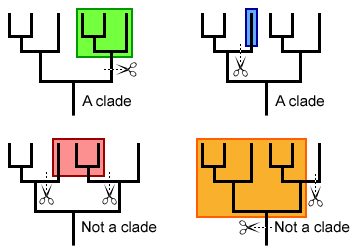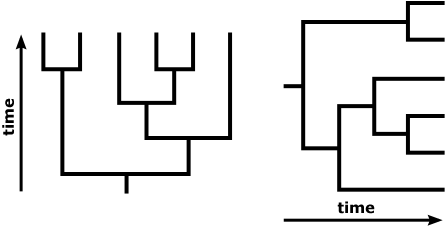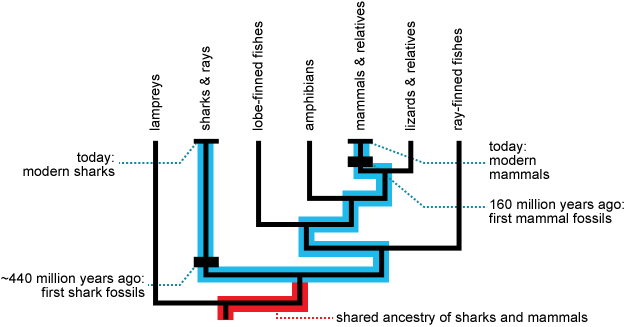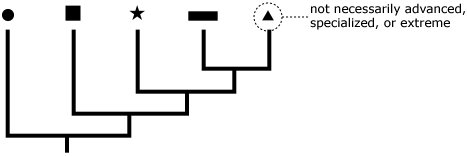 Last week I offered a long introduction to evolutionary trees—so long that we didn’t get to the misconceptions! But as you realized, some common vocabulary is required if we’re going to make sense of evolutionary trees. I felt that it was worth the time to get it all straight—even if we don’t 100% agree on 100% of the terms (I’m looking at you, John Harshman!)
Last week I offered a long introduction to evolutionary trees—so long that we didn’t get to the misconceptions! But as you realized, some common vocabulary is required if we’re going to make sense of evolutionary trees. I felt that it was worth the time to get it all straight—even if we don’t 100% agree on 100% of the terms (I’m looking at you, John Harshman!)
And I hope you’ll forgive me if I delay a tad longer on the misconceptions, because I want to pause and talk a bit about jargon. Avoiding jargon is probably the most universal and useful piece of advice that science communicators get—the old KISS (keep it simple, stupid) strategy. It’s wonderful when scientists successfully avoid jargon—in fact, I’m participating in a conference right now (ComSciCon.com) that is all about training science grad students to communicate science with less jargon. The underlying message of the conference is that if you can’t explain why your work is important then you have no hope of gaining support from the community. You know the infamous Wastebook that Senator Colburn used to compile every year, the list that gleefully calls out what Coburn regards as wasteful government spending? You know why scientific studies appear so frequently in it? Because most scientific communication, be it paper, grant, talk, or press release, is too dense and jargon-laden to be understood and rarely paints a big picture for its audience. The result is low-hanging fruit for someone that wants to suggest science is a wasteful and pointless endeavor.
Okay, so why then did I want to introduce all those technical terms in part 1? Aren’t I contradicting myself? I didn’t think I was until I talked to my colleague Emily Schoerning who specializes in this stuff. My original thinking was that jargon is not jargony if it is first clearly explained in common terms. Most scientists will agree that it’s often a lot easier to explain concepts using scientific language, and I thought hey, if I define it for you, I did my job. And while I maintain that you absolutely must define any jargon you use, Emily (and her research) has cracked my confidence in the sufficiency of this  practice. A case in point: I thought that being able to use “clade” would be a whole lot easier than constantly saying “a group of organisms that all share a common ancestor and that are more closely related to each other than to any organisms outside of the group.” I mean, I have a word count to consider if nothing else! So, since I wanted to use the term, I took the time to define it, and I was feeling pretty good about using the term “clade” from here on out. Emily suggested that a better approach would have been to keep using the plain-words definition until over and over and then swoop in after annoying you with the wordiness of the concept and say—hooray! There is a term for this that we can use! Isn’t that great? And then you the audience would have internalized both the concept and the term. Definitely food for thought and something I hope Emily and I can continue to discuss.
practice. A case in point: I thought that being able to use “clade” would be a whole lot easier than constantly saying “a group of organisms that all share a common ancestor and that are more closely related to each other than to any organisms outside of the group.” I mean, I have a word count to consider if nothing else! So, since I wanted to use the term, I took the time to define it, and I was feeling pretty good about using the term “clade” from here on out. Emily suggested that a better approach would have been to keep using the plain-words definition until over and over and then swoop in after annoying you with the wordiness of the concept and say—hooray! There is a term for this that we can use! Isn’t that great? And then you the audience would have internalized both the concept and the term. Definitely food for thought and something I hope Emily and I can continue to discuss.
Got it? Okay, so next week…
Just kidding. I think we can sneak in at least one misconception this week…and it relates back to a Misconception Monday favorite—the good ol’ great chain of being.
Misconception: Trees are arranged such that the least advanced organisms are on the left and the most advanced organisms are on the right.
Correction: Trees are arranged to show relatedness, and there is no correlation between the horizontal position of a taxon and…well, anything.
 Since trees don’t have to be drawn with organisms placed along the horizontal axis at all, this misconception can be busted on a technicality alone. That aside, there are a few intertwined issues in this misconception. Let’s tackle the idea of advancement first—and it’s one we’ve covered before. There is no standard way to measure “advancement”—are we talking size? Climbing ability? Speed? Tendency to spew out your guts and then regrow them (my shout-out to sea cucumbers!). Cuteness? (Did anyone see the new pink deep-sea octopus? It’s absurd how cute it is. Hence the proposed binomial Opisthoteuthis adorabilis.) You get the idea. So, we all need to help students step away from this notion—however intuitive it may be.
Since trees don’t have to be drawn with organisms placed along the horizontal axis at all, this misconception can be busted on a technicality alone. That aside, there are a few intertwined issues in this misconception. Let’s tackle the idea of advancement first—and it’s one we’ve covered before. There is no standard way to measure “advancement”—are we talking size? Climbing ability? Speed? Tendency to spew out your guts and then regrow them (my shout-out to sea cucumbers!). Cuteness? (Did anyone see the new pink deep-sea octopus? It’s absurd how cute it is. Hence the proposed binomial Opisthoteuthis adorabilis.) You get the idea. So, we all need to help students step away from this notion—however intuitive it may be.
 But perhaps you—or your students—are thinking about advancement in terms of time: the longer a group has been evolving, the more advanced it is (or its members are). If so, then first of all, remember that all living organisms have histories extending back over the same amount of time. A tiger shark is not more or less evolved than a tiger just because sharks have a more ancient origin than mammals. If you track both back to their common ancestor, each line of descent extends over exactly the same span of time. And second of all, time doesn’t run along the tips of the branches in a tree. Rather, it runs from the root to the tips. So you’d still be wrong if you tried to assign some kind of older-younger order to the organisms based on their left/right position. And last of all—and this is the kicker—nodes (points at which branches meet) can rotate.
But perhaps you—or your students—are thinking about advancement in terms of time: the longer a group has been evolving, the more advanced it is (or its members are). If so, then first of all, remember that all living organisms have histories extending back over the same amount of time. A tiger shark is not more or less evolved than a tiger just because sharks have a more ancient origin than mammals. If you track both back to their common ancestor, each line of descent extends over exactly the same span of time. And second of all, time doesn’t run along the tips of the branches in a tree. Rather, it runs from the root to the tips. So you’d still be wrong if you tried to assign some kind of older-younger order to the organisms based on their left/right position. And last of all—and this is the kicker—nodes (points at which branches meet) can rotate.
Nodes can rotate. Let that sink in. This is a big misconception-busting fact that we will revisit. Rotate any set of branches around a node. You have in no way disrupted the evolutionary relationships modeled by the tree. And guess what happens if you rotate nodes? The left/right order of the terminal taxa (organisms or groups of organisms at the branch tips) changes. So in sum: the horizontal (or vertical if the tree is “sideways”) position of organisms on an evolutionary tree has nothing at all to do with how evolved, advanced, awesome, ancient, adorable, scary, or phenomenal the organisms are.
More tre es next week! In the meantime, see if you can find some trees whose creators resisted the temptation to draw them to consistently branch up and out to the right. In other words, let’s try and find some trees with cool branch rotations that challenge us to bust out of the left to right mode of tree-reading.
es next week! In the meantime, see if you can find some trees whose creators resisted the temptation to draw them to consistently branch up and out to the right. In other words, let’s try and find some trees with cool branch rotations that challenge us to bust out of the left to right mode of tree-reading.
Are you a teacher and want to tell us about an amazing free resource? Do you have an idea for a future Misconception Monday or other post? See some good or bad examples of science communication lately? Drop me an email or shoot me a tweet @keeps3.
All images are from University of California Museum of Paleontology's Understanding Evolution (http://evolution.berkeley.edu).

